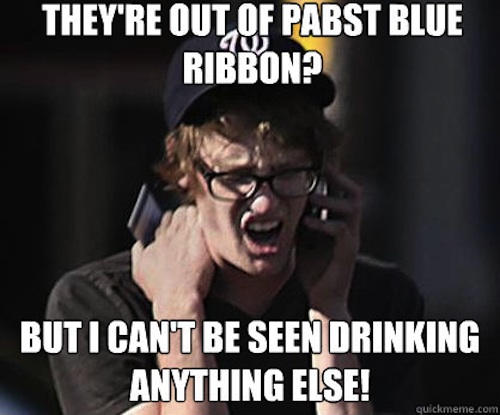Check out that chart above, by way of Quartz here. PBR — which essentially barely advertises — is literally crushing the major light-beer brands, most of whom spend millions advertising. That makes no sense, though — right? We take these MBAs and we pay them six-figure salaries to figure out innovative marketing strategies that reach the target demos, no? I mean, that’s how it works, right? Right? But maybe that’s not the best way to reach your target demo.
PBR is an OK beer. It’s light and it’s easy to drink, and there’s a cache to ordering it. It’s essentially the same as 12 other light beers you could order at a given bar. Why pick that one? The oft-stated theory is that “hipsters love it.” Indeed. To wit:
Even if you haven’t had the pleasure of tasting PBR, however, you’ve probably heard of it. That’s not because you’ve been bombarded with advertisements. Rather, it may be because you never were. After observing the beer’s unexpected popularity in Portland, Oregon back in 2001, the company concluded that people were buying the beer because it wasn’t aggressively being pitched to them. “Hipsters fetishize the lowbrow culture of the ’70s and ’80s,” Salon observed in 2008. “The hipster’s beer of choice is always going to be a cheap one.”
Funny thing is, it isn’t even the cheapest light beer. It’s actually been climbing in price. It’s entirely possible, then, that the rise in demand for PBR is actually based on the “no marketing strategy.” Consider this: in 2009, their sales jumped 25 percent. 2010? 18 percent. 2011? 14 percent. Those numbers are dropping, but they’re all still positive. In 2006, they overtook Coors in volume; in 2010, they surpassed Sam Adams. (No one is going to catch Budweiser anytime soon.) The brand’s up for sale now, and might be worth $1 billion.
Here’s a solid thread on the rise of PBR, including this nugget:
Around 2001, there were a couple of interesting things that popped up. Kid Rock wore a PBR belt buckle, and some top snowboarders in Utah adopted PBR as their drink of choice. Most likely these were intentionally ironic actions, but these days, who knows? Also, people in Portland were drinking it too. This was all brought to the notice of a newly hired marketer named Neal Stewart, who was only 27 at the time, and soon rose to be the brand marketing manager.
So he went around the bars in Portland and he started handing out PBR schwag. He wouldn’t be dressed PBR, and he would never overtly advertise. He’d just sit there, and people would come up to him and ask for the stuff that most other beer companies could never force on people. The people liked PBR because it was scarce, cheap, and plagued with persistent rumors of imminent bankruptcy. Neal saw this, and decided to cash in on it. Under him, PBR’s marketing was to do as little as possible. When Kid Rock came around to ask for an endorsement they told him to shove it, and made it public. When the Pro snowboarders offered for PBR to endorse their competitions, PBR did nothing, but they made sure people knew they were doing nothing with the big guys.
Instead, who they sponsored were the Portland hipsters. They sponsored skateboarding meets, art galleries, independent publishers, and they did it in such a way as to not appear corporate. And with every little event they sponsored, they built their network, they built brand loyalty among subcultures that hate corporations, hate marketing, and were previously thought immune to such tactics. Having Kid Rock endorse them would have cost 500k, hiring 10 reps per city to go convince small bars and neighborhood institutions to carry PBR cost the same and was much more effective. In 2003, at the peak of these marketing campaigns, half of PBR’s whole workforce was involved in these marketing efforts, and in the end, it was such grass roots marketing that got PBR firmly established as the hipster beer of choice.
So there it is: if your audience is the ironic hipster of the early 2000s, you want to do as little as possible. As more millennials become the primary purchasers of households, this could work in some cities, for sure. The marketing of no-marketing. Embrace it.

